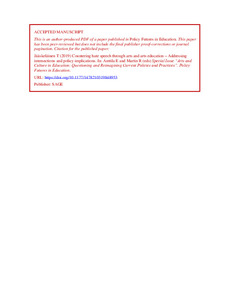Countering hate speech through arts and arts education: Addressing intersections and policy implications
Jääskeläinen, Tuula (2019)
Jääskeläinen, Tuula
Sage
2019
1478-2103
ACCEPTED MANUSCRIPT This is an author-produced PDF of a paper published in Policy Futures in Education. This paper has been peer-reviewed but does not include the final publisher proof-corrections or journal pagination. Citation for the published paper: Jääskeläinen T (2019) Countering hate speech through arts and arts education – Addressing intersections and policy implications. In: Anttila E and Martin R (eds) Special Issue “Arts and Culture in Education: Questioning and Reimagining Current Policies and Practices”. Policy Futures in Education. URL: https://doi.org/10.1177/1478210319848953 Publisher: SAGE
lehtiartikkeli
Julkaisun pysyvä osoite on
https://urn.fi/URN:NBN:fi-fe202002246328
https://urn.fi/URN:NBN:fi-fe202002246328
Tiivistelmä
Hate speech has become a growing topic of discussion and debate on a global scale, especially as advances in the internet transform communication on many levels. Among scholars, hate speech has been defined as any form of expression – for example by means of speech, images, videos, or online activity – that has the capacity to increase hatred against a person or people because of a characteristic they share, or a group to which they belong. In order to maintain the integrity of a functioning democracy, it is important to identify the best balance between allowing freedom of expression and protecting other human rights by countering hate speech. In addition to strengthening the legal framework to address the cases when hate speech can be considered criminal, and developing automated monitoring of online systems to prevent the spreading of cyberhate, counter narratives can be utilised by the targets of hate speech and their communities to create campaigns against hate speech. The employment of artists’ expression and arts education have great potential for creating different counter narratives to challenge one-sided narratives and hate speakers’ simplified generalisations. Because hate speech is not an easy issue to address in schools, clear research evidence, concrete guidelines, and practical examples can help teachers to contribute, along with their students, in combating it. A great body of evidence supporting the beneficial social impacts of the arts and culture fields is already available, but much more research, backed by sufficient resources, is needed to evaluate the impact and effectiveness of intervention strategies in countering hate speech through arts education.
